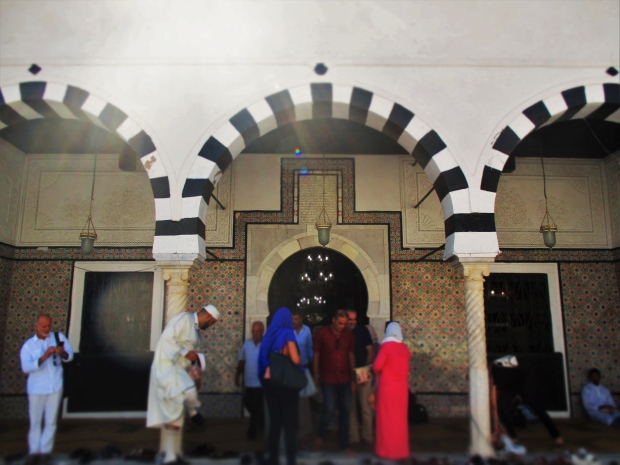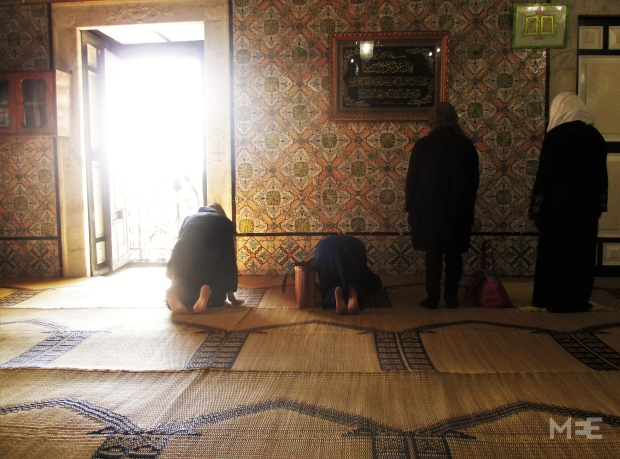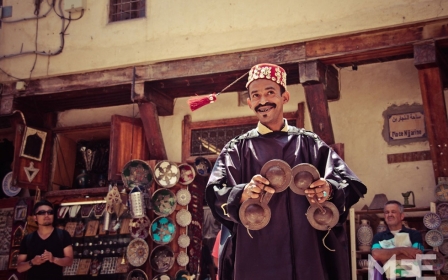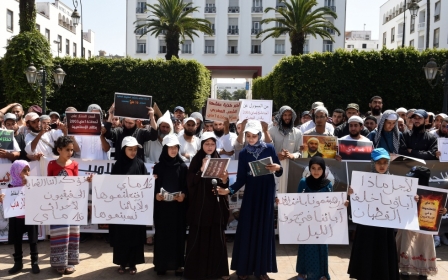Sufi women break norms by leading sacred song rituals in Tunisia
TUNIS - Once a week, over the summer, a group of women gather at the Sidi Belhassen Zawiya (shrine) in Tunis to participate in the Hadra, a Sufi ritual that involves the performance of songs accompanied by sacred rhythms.
The shrine, located at the top of the al-Jallaz cemetery on the south side of Tunis, is home to the Shadhili Tariqa, an order of Sufi followers that was founded by Abu Hasan al-Shadhili, a Sufi saint and scholar of Moroccan origin, in the 13th century.
Women trickle into the inner courtyard of the shrine, some wearing djellebas (a traditional Tunisian dress) while others wear formal business attire. The atmosphere is relaxed as women sit alongside one another on the woven mats, displaying an innate closeness. One woman lights a cigarette. Children dart across the courtyard and run their hands through water from a sacred well, thought to bring blessings.
The Tijaniya (female musicians) prepare for the ritual by leaving their drums sitting out in the sunlight for 10 to 15 minutes. This allows the drum skins to get warm which helps them be more in tune.
In the meantime, one of the caretakers of the shrine walks around carrying an enormous bowl of couscous that is to be eaten by the ritual attendees.
When a newer attendee refuses her share, the caretaker insistently gives her a spoonful, saying: “In here, you eat!”
Dia Bargouthi, a 26-year-old playwright and researcher, has spent the last three years conducting research on the Shadhili community in Tunis. When she first arrived in Tunisia, it was only for a short visit. “But when I came to [Sidi Belhassen] I just knew that I was going to live here.”
“I started out by going to the prayers (dhikr). And then, over the summer, I began going to the Hadra. I chose the Hadra because I liked the music and this was one of the things that initially drew me Sufism.
"As soon as you hear it, you start to move your body without even thinking and it feels really instinctual. But then over time I started to really appreciate the prayer as well. The various [rituals] are all just different tools for reaching a certain truth… that’s part of the beauty of Sufism.”
But not everyone shares Balgouthi’s point of view. When it comes to the Hadra, there is some disagreement as to how it fits into Sufism.
Secular changes to the ritual
Souhail, who grew up going to Sidi Belhassen on a weekly basis, says that while he enjoys attending the Hadra, he views it as more of a “show” than a religious ritual.
He is not the only one, and while he views the Hadra as an integral but not spiritually significant part of the Shadhili, he feels that some of the performers are doing it for the wrong reasons.
“The problem,” he says, “is that some practitioners of the Hadra do not understand the [religious] origins of what they are doing… while others are performing the Hadra for their own personal profit.”
This viewpoint has evolved out of social and political changes affecting the Hadra performance over the past century. In particular, the issues of "de-contextualisation" and “personal profit” relate to the secularisation of the Hadra ritual, one of the topics that Balgouthi has covered in her research.
“In the 1960s, a lot of jazz musicians became interested in Sufi music. Jazz musicians made collaborations with Sufi musicians, who would then perform for people who didn’t understand its religious and spiritual significance. People transformed from being spiritual guides into being labourers.”
This led to what Balgouthi refers to as the “commodification” of the ritual. At the same time, she explains, a political push to “modernise” post-independence Tunisia meant that religious spaces, such as the Sufi zawiyas, no longer received as much state support, and often lacked the money necessary to maintain the spaces.
These conditions further pushed some Sufi musicians to opt for performing in a non-religious context, setting the scene for what is now one of several polarising factors within the Sufi community.
The rising hardline Salafi threat
In recent years, Tunisia’s growing hardline Salafi movement has also posed a serious threat to the openness and diversity of the Sufi community.
Since the revolution in 2011, some hardline Salafists have burned or destroyed over 40 Sufi shrines across the country. Even in Tunis, a number of previously active shrines have limited their ritual practices for fear of becoming easy targets for more attacks.
Salafism, which is based upon a literal interpretation of the Quran, rejects the notion that religious practices can be manifested differently according to local and cultural contexts. This comes into conflict with the philosophical underpinnings of Sufi doctrine, which allow for what Balgouthi describes as “distinct social actions and perceptions of reality,” as based upon the spiritual experiences of the individual/community.
The Shadhili community, despite its large following at Sidi Belhassen, has not been immune to these attacks. According to one of the sheikhs from the shrine, in January 2013, a group of hardline Salafis were found with gasoline canisters which they intended to use to set fire to the shrine, but the incident was kept relatively quiet in order to avoid bringing too much attention to the matter, fearing further attacks.
Fearful and forced to take on a more defensive role, some members of Shadhili and the greater Sufi community, have opted to disassociate themselves from ritual practices that have a musical dimension which are more susceptible to accusations of idolatry, such as the Hadra. This leaves groups such as the Tijaniya at Sidi Belhassen particularly vulnerable to being suppressed or silenced.
“Even though Sufism is practised by a large proportion of the Tunisian population, it is not part of the mainstream [public] discourse. The Sufi community is marginalised both by Islamists and by secularists,” says Balgouthi.
Differing views on spiritual nature of ritual
Even prior to the current threats, some of the more conservative Sufi orders in Tunisia refused to perform the Hadra, which is sometimes perceived as being an "ecstatic" ritual.
The "ecstatic" description of the Hadra stems from the intense physical and psychological reactions that sometimes take place.
At a recent ritual, as the woman chant and the rhythmic intensity of the Hadra increases, one of the women goes into a trance-like state, crying out as one woman cradles her body while another places a hand over her forehead.
“I think some people see these sort of physical outbursts negatively,” explains Balgouthi. “There is a historical debate about how much you should display if you have a spiritual realisation and this aspect [of the Hadra] is frowned upon by some people in Sufism… but I don’t think that the sheikhs at Sidi Belhassen share this opinion.”
One should also be careful not to reduce women’s participation in the Hadra to a spiritually insignificant ritual founded upon a need for social and/or emotional release.
Though certainly a social process, conversations surrounding the Hadra also indicate each attendee’s distinctive and often highly spiritual engagement with the ritual.
One woman, who has been known to attend every single ritual at the shrine, explains that she first came to Sidi Belhassen on her own.
“I heard a woman reading the Quran incorrectly and I wanted to learn how to recite it properly. I started by learning at the Zitouna mosque and then I came here. God told me to come.” Afterwards, she whispers, “what I have just told you is a secret,” making reference to the shared Sufi belief that everyone has their own specific path and intimate relationship to God.
A strong community
Though there is an undeniably gendered element to the Hadra, Balgouthi also sees this as a reflection of the wider socio-cultural context in Tunisia and not a reflection of tensions between the men and women at the shrine.
For instance, while the Hadra is mostly attended by women, men are often present at the ritual, “preparing the space, making coffee for the women and even [occasionally] participating in the Hadra itself.”
This is one of the many ways in which members of the Shadhili support one another and build resilience in the community, despite existing in what could currently be described as a hostile environment.
Balgouthi smiles, remembering a particularly emotional moment last year when one of the women musicians went down to complain to the sheikh because they were being asked to finish the music earlier than usual. “They weren’t even arguing but they both ended up crying and the sheikh kissed the [female] caretaker’s forehead.”
“Even though there are problems, I think they really love one another.”
There is a saying that the shrine's caretaker often repeats throughout the ritual with great enthusiasm: "If you love al-Shadhili then you are Shadhili!" By this she means that whoever loves the saint - and implicitly, God - automatically belongs to the Shadhili community. It is this uncomplicated openness and conception of faith that distinguishes the community and suggests that, in spite of challenges faced in recent years, the followers at Sidi Belhassen are here to stay.
This article is available in French on Middle East Eye French edition.
New MEE newsletter: Jerusalem Dispatch
Sign up to get the latest insights and analysis on Israel-Palestine, alongside Turkey Unpacked and other MEE newsletters
Middle East Eye delivers independent and unrivalled coverage and analysis of the Middle East, North Africa and beyond. To learn more about republishing this content and the associated fees, please fill out this form. More about MEE can be found here.







